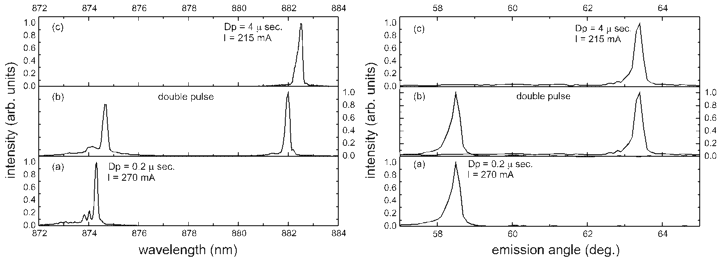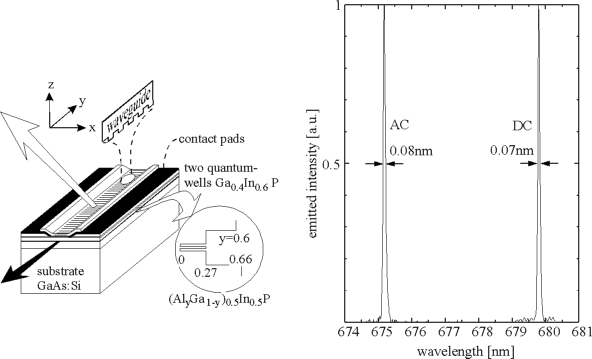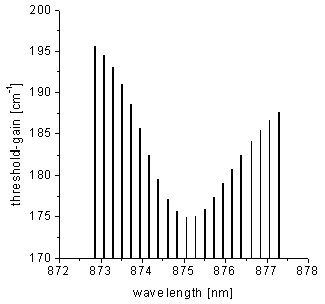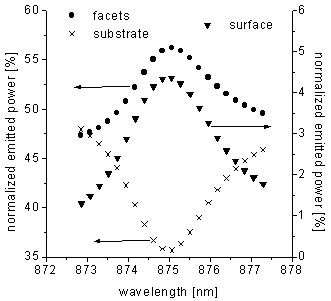
Novel Single-Mode Emission Laser Diodes Based on Surface-Mode Coupling
N. Finger, A. Golshani, P.O. Kellermann, A. Köck, E. Gornik
Institute of Solid State Electronics &
Center of Microstructure Research (MISZ), Techn. Univ. Vienna
A-1040 Vienna, Austria
We present novel laser diode devices based on the surface-mode-emission (SME) concept. An array of single-mode and single-beam surface emitting laser diodes was realized. The emission wavelengths of the individual laser diodes were controlled by a postgrowth adjustment of the surface structure. The resulting average wavelength spacing is 1.1 nm with a deviation of 0.13 nm. The side mode suppression ratio (SMSR) was measured to be 20 dB in the best case. A beam-steering device based on a SME-laser diode is presented, which is capable of steering digitally a single, surface emitted beam with a divergence of 0.2° and a steering-range of 4.9°. The beam steering is achieved by a thermal mode-switching between two single-mode emission wavelengths. A single-mode visible red GaInP/AlGaInP laser diode with a side mode suppression of 19 dB was realized. A theory based on a Floquet-Bloch expansion was developed to investigate the underlying waveguide structures of SME laser diodes numerically.
Introduction
Semiconductor laser diodes have an important impact in the area of light wave transmission systems for optical telecommunication. In order to achieve high data transmission rates single-mode lasers are required to build up high-speed data highways using Wavelength-Division-Multiplexing (WDM). Various types of single-mode laser diodes like distributed-feedback (DFB) lasers, distributed-Bragg-reflector (DBR) lasers, coupled-cavity lasers and vertical-cavity-surface-emitting lasers (VCSELs) have been realized so far. Today most commonly DFB lasers are used for the purpose of optical telecommunication [1], [2].
Beam steering devices are expected to have many novel applications in future free-space optical communication systems like free-space communication between satellites, optical data storage and data reading and future optical computers [3], [4]. Incorporating the steering mechanism within the laser diode is the most efficient approach. Edge emitting [5], [6] as well as surface emitting [7], [8] laser diode beam steering devices have already been realized.
Semiconductor single-mode laser diodes in the visible regime are very suitable to be employed as light sources in the next generation optical disk drives because of their ability of reading and writing highly condensed optical information [9].
The surface-mode-emission (SME) concept, which was successfully applied to realize single-mode and single-beam surface emitting diode lasers [10], [11], was exploited to realize a variety of optoelectronic devices: A novel device for WDM applications with postgrowth wavelength adjustment was realized. The SME technique was also used to make a laser diode beam-steering device. Furthermore, a single-mode and single-beam surface emitting visible red laser diode is presented. Hence the proposed flexibility of the SME-concept is proved. In order to improve the design of the SME-laser diodes a theory was developed to perform device simulation as far as the optical properties are concerned.
Experimental
Five-Wavelength Surface Emitting Laser Diode Array
We report on a five-wavelength surface emitting laser diode array achieved from monolithically integrated SME laser diodes [12]. The array consists of 15 laser diodes divided into five groups. The laser diodes of each group are assigned to emit the same wavelength. Each group emits at a different wavelength by a postgrowth-adjustment of the thickness of the surface waveguides. The emitted wavelengths vary from 867.92 nm to 872.67 nm and the average wavelength spacing is 1.1 nm with a wavelength deviation within the groups of 0.13 nm.

Fig. 1: Left: Schematic structure of the SME diode laser array. The thickness of the surface waveguide is slightly different on each laser diode group which leads to emission of different wavelengths. Right: Spectra of the array elements from first group (bottom layer) to fifth group (top layer). The waveguide thickness decreases from the first group to the fifth group.
The samples are MOCVD-grown GaAs/AlGaAs double heterostructure diode lasers consisting of an n-Al0.35Ga0.65As cladding layer grown on an n-GaAs substrate followed by the GaAs active region (90 nm thick) and the 550 nm thick p-Al0.3Ga0.7As top cladding layer. The crucial difference to conventional diode lasers is a surface-relief grating (period L = 415 nm, 100 nm deep) etched by ion-milling covered with a semitransparent AuZnAu film (thickness 5/5/20 nm) and a spin coated photoresist layer (AZ6615; d ~ 300 nm) forming a surface waveguide (schematic drawing: see Fig. 1 left).
The single mode surface emission is a consequence of the excitation of the TE0 surface-mode in the surface waveguide: The laser light in the active region couples via one grating vector kg = 2p/L to the TE0 mode. The excited TE0 surface mode either couples back into the laser structure, thus providing an active feedback resulting in single-mode operation, or decays via one grating vector into the air as the surface emission. By thinning the surface waveguide the dispersion relation of the TE0 shifts, resulting in a shift of the emission wavelength towards longer wavelengths.
On the laser array the surface waveguide thicknesses of all laser diodes were thinned to ~ 255 nm by low power plasma ashering for single mode emission around 868 nm. Then the waveguide thicknesses of the distinct laser groups were adjusted by low power plasma ashering resulting in thickness differences of 2.2 nm between the groups.
Fig. 1 shows the measured emission spectra of the array. The samples were driven under pulsed conditions with the same current and duty cycle (pulse width = 0.5 µs; frequency = 30 kHz). The typical threshold current density is 1.8 ± 6% kA/cm2 over the array. Every laser diode shows single mode operation with a side mode suppression ratio (SMSR) of about 20 dB in the best case. The average full width at half maximum (FWHM) was measured to be 0.08 nm. The total emitted power of one individual laser is about 35 mW. About 20% of the power is emitted into a single surface beam with a FWHM of 0.12°. Single mode emission is achieved at a current of 1.1´ Ith retaining up to 1.4´ Ith. The wavelength spacing between laser diode groups is 1.1 nm in average and the average deviation within each group is 0.13 nm.
Digital Beam Steering from SME Laser Diodes
We present a GaAs/AlGaAs laser diode beam steering device based on a single-mode SME-laser diode [13]. The temperature-dependence near room-temperature of the emitted wavelength of the SME laser diode was investigated: At temperatures below 285 K the mode near 871 nm is emitted. Heating the sample results in a red-shift with a rate of 0.07 nm/K, which is actually less then the rate of 0.09 nm/K for DFB lasers. After the temperature is raised to 286 K the mode near 878 nm is preferred. The emitted wavelength continues to shift towards longer wavelengths at the same rate as before. Thus a bistable operation of the laser diode can be achieved adjusting the temperature of the sample.
Since the angle of the surface emission a = arcsin(neff·2l/L) (neff = 3.39 is the effective refractive index of the laser structure and L is the grating period) depends on the wavelength l, a switching between different wavelengths yields a switching between different angles. Driving the laser diode with short current-pulses (I = 270 mA, pulse width Dp = 0.2 µs) results in a single-mode and single-beam emission at l1 = 874.13 nm and a1 = 58.5°. Applying longer pulses (I = 215 mA, pulse width Dp = 4 µs) leads to a heating of the sample and results in an emission at l2 = 874.13 nm and a2 = 63.4° (see Fig. 2). The beam divergence is in both cases 0.2°. Driving the laser diode with double pulse sequences yields the desired mode switching and the digital beam steering between a1 and a2 with a steering range of 4.9°. As the mode switching is based on thermal effects, the maximum frequency of applying double pulses is limited to 0.15 MHz.

Fig. 2: Short-pulse operation of the device results in single-mode and single-beam operation at l1 = 874.13 nm and a1 = 58.5° (a). Long-pulse operation yields emission at l2 = 874.13 nm and a2 = 63.4° (c). Double pulses yield mode-switching and thus digital beam-steering (b).
SME Laser Diodes in the Visible Regime
The SME technique was successfully applied in the visible red wavelength regime to achieve single-mode emission in AC and in DC operation as well as single-beam emission via the surface [14]. The devices realized in this work are MOVPE-grown compressively strained double-quantum well GaInP/AlGaInP laser diodes. The asymmetric cladding layers (by the aspect of thickness and refractive index) are designed to shift the distribution of the optical field towards the surface to achieve a sufficient coupling between the laser light and the TE0-surface mode. The first order grating for surface mode coupling (grating period = 328 nm, height = 100 nm) was etched into the top cladding layer (thickness 400 nm) using ion milling. The surface-waveguide structure is formed by a semitransparent AuZnAu film (5/5/20 nm thick) and a spin-coated photoresist (AZ6615) slab waveguide (schematic sample structure: see Fig. 3 left).
The SME laser diodes have threshold current densities between 1.4 kA/cm2 for AC- and 1.9 kA/cm2 for DC-operation. Single mode emission is achieved both in AC- and DC-operation with a side mode suppression of 19 dB in the best case. Fig. 3 shows single-mode emission spectra for AC- and DC-operation: The emitted wavelengths are l = 675.17 nm (driving current I = 1.2´ Ith, f = 16.6 kHz, pulse width wp = 4 µs) with a FWHM of 0.08 nm for AC- and l = 679.79 nm (driving current I = 1.1´ Ith, FWHM = 0.07 nm) for DC-operation. The farfield of the single-beam surface emission has a beam divergence of 0.16° in the y-direction. Presently a power of 2 % (0.14 mW) of the whole light power (7 mW at I = 1.7´ Ith) is emitted via the surface.

Fig. 3: Left: Schematic sample structure of the SME-laser diode. Right: Single-mode emission spectra for AC-operation (I = 1.2´ Ith, f = 16.6 kHz, wp = 4 µs) and DC-operation (I = 1.1´ Ith).
Theory
In order to understand the coupling mechanisms within SME laser structures profoundly, the underlying waveguide structure (i.e. metallized surface-relief grating coupled waveguides) was investigated numerically. The analysis is based on a Floquet-Bloch expansion of the optical field [15]. Propagation constants and optical field distributions can now be calculated without a priori assumptions. In a further step coupling coefficients are extracted from the Floquet-modes providing the possibility of device-simulation using coupled mode theory. Longitudinal mode spectra and the radiation characteristics of SME lasers are calculated.
Fig. 4 shows the results for a SME laser structure based on a GaAs/AlGaAs-double-hetero-laser structure (sample W688): The tooth-shaped coupling-grating (period = 535 nm, height = 100 nm, duty cycle = 0.5), covered with a 30 nm thick Au-film, is followed by a SiO/SiN-surface waveguide (100 nm/425 nm thick). The cavity is taken to be 500 µm long with as cleaved facets. The longitudinal mode spectrum (threshold-gain vs. wavelength) and the radiation properties show a resonant behavior around 875 nm (TE0 resonance). The plotted output powers via the facets, via the surface and into the substrate are normalized with respect to the power generated in the active region by stimulated emission. The total waveguide losses decrease in case of TE0 resonance due to a reduction of the radiation losses into the substrate because a supermode of the twin-waveguide-system (laser-waveguide, surface-waveguide) is excited. On the contrary, the desired radiation losses via the surface increase due to an efficient coupling between the TE0 surface-mode and the radiation field emitting into the air.


Fig. 4: Left: Calculated longitudinal mode spectrum. Right: Calculated output-powers, normalized with respect to the power generated by stimulated emission. The TE0-resonance occurs at 875 nm.
Conclusion
Compared to DFB laser diodes the SME laser concept has various advantages. No regrowth processes are required and the device fabrication is simple and very flexible. Especially for WDM applications the possibility of post-growth wavelength adjustment makes the SME concept very suitable because monolithically integrated devices can be fabricated easily.
The major problem to be solved is the poor side mode suppression under high-injection conditions. To overcome this problem narrow index-guided laser structures have to be made to avoid the excitation of higher lateral modes. Recent calculations showed that a dramatic improvement of the wavelength-filter characteristics of the laser structure can be achieved by using contradirectional surface-mode-coupling instead of codirectional coupling. By changing the type of coupling the spectral linewidth of the surface-mode resonances can be decreased by one order of magnitude, which will result in a significant increase of the SMSR.
In the visible wavelength regime (especially for green and blue laser diodes) the SME concept has to be preferred rather than the DFB concept to achieve single-mode laser diodes. DFB laser diodes demand gratings with extremely small periods (100 nm and less), which would cause complicated and thus expensive device-processing (e-beam-lithography). SME lasers require longer grating-periods which can be processed easily using optical lithography.
Acknowledgments
This work was also sponsored by the Stiftung Volkswagen, Hannover, Germany.
References
[1] J. Buus: "Single Frequency Semiconductor Lasers", Tutorial texts in optical engineering, Vol. TT5, SPIE Optical Engineering Press (1991)
[2] T. Ikegama: in "Optoelectronic Technology and Lightwave Communications Systems", edited by C. Lin, Van Nostrand Reinhold, New York (1989)
[3] J.A. Neff: Opt. Eng. 26, 2 (1987)
[4] A. Hartmann, S. Redfield: Opt. Eng. 28, 315 (1989)
[5] D.R. Scifres, W. Streifer, R.D. Burnham: Appl. Phys. Lett. 33, 616 (1978)
[6] Y. Sun, C.G. Fanning, S.A. Biellak, A.E. Siegman: IEEE Phot. Technol. Lett. 7(1), 26 (1995)
[7] Y. Kan, Y. Honda, I. Suemune, M. Yamanishi: Electron. Lett. 22, 1311 (1986)
[8] N.W. Carlson et al.: Appl. Phys. Lett. 53, 2275 (1988)
[9] A.E. Bell: "Next-generation compact discs", Scientific American (International Edition), July 1996, vol.275, (no.1):28-32
[10] A. Golshani, A. Köck, S. Freisleben, C. Gmachl, E. Gornik, L. Korte, "Adjustable surface emission from AlGaAs/GaAs-laser diodes based on first-order-grating-coupled surface mode emission", Appl. Phys. Lett. 69 (16), 2312 (1996)
[11] A. Köck, A. Golshani, R. Hainberger, E. Gornik, L. Korte, "Single-mode and single-beam emission from surface-emitting laser diodes based on surface mode emission", Appl. Phys. Lett. 69 (24), 3638 (1996)
[12] A. Golshani, P.O. Kellermann, A. Köck, E. Gornik, L. Korte: "Five-Wavelength Surface Emitting Laser Diode Array Based on Post Growth Adjustment of Emission Wavelength", Appl. Phys. Lett., 71, 762 (1997)
[13] A. Köck, A. Golshani, R. Hainberger, E. Gornik, L. Korte: "Digital beam-steering from surface emitting laser diodes based on surface mode emission", SPIE Proceedings Series, 3001 "In-plain semiconductor lasers: from Ultraviolet to Mid-Infrared", p.192, OE/LaSE’97, USA, SPIE Optical Engineering Press (1997)
[14] P.O. Kellermann, A. Golshani, A. Köck, E. Gornik, H.P. Gauggel, R. Winterhoff, J. Pilkuhn: "Single-Mode and Single-Beam Surface Emission from Visible Red GaInP/AlGaInP Laser Diodes", Appl. Phys. Lett. 70, 2374 (1997)
[15] R.J. Noll, S.H. Macomber, "Analysis of Grating Surface Emitting Lasers", IEEE J. Quantum Electron. vol. QE-26, pp.456-466, 1990
Project Information
Project Manager
Dr. Anton Köck
Institut für Festkörperelektronik, Technische Universität Wien
Project Group
|
Last Name |
First Name |
Status |
Remarks |
|
Finger |
Norman |
dissertation |
|
|
Golshani |
Alireza |
dissertation |
|
|
Gornik |
Erich |
Full Prof. |
|
|
Haider |
Manfred |
student |
|
|
Kellermann |
Peer Oliver |
dissertation |
|
|
Köck |
Anton |
Assistant Prof. |
|
|
Maier |
Thomas |
dissertation |
|
|
Schrenk |
Werner |
dissertation |
|
|
Smola |
Winfried |
student |
|
|
Socher |
Michael |
student |
Publications in Reviewed Journals
Presentations
Doctor’s Theses
Habilitations
Cooperations